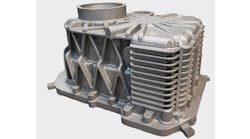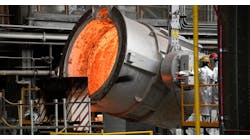Second-Generation Stucco Mixtures Build Investment Casting Shells Rapidly
Cycle time from pattern to poured metal is important for a foundry’s productivity and profitability. Shortening the time to build a shell can decrease this cycle time.
Previously, we developed stucco compositions that contain an amorphous mineral silicate (AMS) additive and built shells rapidly.[1-5] These compositions could be used with standard slurry and applied using fluidized beds and the rainfall method. The AMS additive works well, but it has an underlying dust problem because of the very small size of the AMS particles.
We successfully eliminated the dust by applying a small amount of guar gum and polyethylene glycol 300 (PEG 300) to coat the stucco mixture. These are coatings that industry uses to coat materials with very fine particle size to reduce dust problems. But, because we only used small amounts of stucco for the tests, the amount of coating that was applied was hard to control, which would have been solved by going to much larger batch sizes. We looked for other stucco mixtures that would not have dust issues.
Recently, we have developed a new set of stucco mixtures[6] that contain fused silica, activated alumina, and molecular sieve. They are compatible with traditional slurries and standard application methods. We call this new mixture Second Generation stucco, or 2-G stucco, or 2-G for short. The stucco with AMS additive is First Generation stucco. Shells made with 2-G stucco can be used with ferrous and low-temperature, nonferrous alloys.
In one study, several components were used in the slurry and stucco, as seen in the sidebar. Working with industry with the 1-G and 2-G stuccos, we find that foundries want to use their standard primary slurry and pure zircon for the face coat, then to use 2-G for the intermediate and backup stuccos.
We made mechanical testing specimens using traditional and 2-G stuccos. These were tested at Minco, a fused-silica manufacturer. We premixed the 2-G stucco components. There was no dust generated when using the mixture in a fluidized bed, and the components did not separate. The 2-G mixture fluidizes well. Figure 1 shows a seven-layer 2-G shell with blind, deep cores that was built and poured in a single shift.
The shell in Fig. 1 has seven layers that were applied with 30 minutes between dips. It did not have a seal coat. The wax was burned out using a flash burner 45 minutes after the last layer was applied. The interior surface of the shell is very smooth with fingerprint-quality surface detail.
Shells made with traditional and 2-G stuccos have very similar mechanical properties, as shown in Table 2. The modulus of rupture (MOR) and modulus of elasticity (MOE) are both slightly higher for shells made with 2-G stucco. The shell thickness is essentially the same as for traditional and 2-G stucco.
Figure 2 shows the surface of aluminum and stainless steel castings from 2-G shells. These parts have fingerprint detail with no surface defects from burn-in or other causes. The dimensions of castings from 2-G shells are essentially identical with castings from traditional shells. There are no permeability issues with 2-G shells. As the metal cooled, the shell broke off in larger pieces with the 2-G stucco than with traditional stucco.
Building a shell with 2-G stucco is essentially identical to using traditional fused silica stucco: they use the same water-based slurry, face-coat slurry and primary stucco, backup slurry, and method of applying the stuccos. 2-G shells need brisk air flow over the shell between dips to remove the evaporating water. This can be done with normal fans. After the shell is built, pattern removal, preheating, and casting are identical for 2-G and traditional stucco shells. 2-G stucco is easy to implement in industrial foundries and requires very little change to current procedures.
Investment casting shells can be built and poured in a single shift using the new 2-G stucco mixtures composed of fused silica, molecular sieve and activated alumina. 2-G stucco is compatible with current foundry production processes and can be used with low-temperature, nonferrous alloys through high-temperature stainless steels. It is particularly good for deep cores.
Eric E. Hellstrom is a professor in the Dept. of Mechanical Engineering at Florida State Univ. Daniel S. McGuire is an associate professor in the Art Dept. at the Univ. of Wisconsin- Whitewater. They encourage readers to contact Paul Pucci for more information, at tel. 608-262-4924, or [email protected]. They express thanks to their co-workers at Minco (Midway, TN) and support from WiSys, WARF, a UW-System grant, research and sponsored programs at UW-Whitewater, and The Center for Innovation and Business Development (UW-Whitewater).
References
1. D.S. McGuire and E.E. Hellstrom, “The Use Of Amorphous Mineral Silicates as a Stucco Additive for Rapid Shell Building,” Investment Casting Institute 54th Technical Conference and Expo, 2006, paper 22, Milwaukee.
2. E.E. Hellstrom and D.S. McGuire, “From Sculpture Lab to Industrial Setting - University Study Explores Building Investment Casting Shells Using Rapid-setting Stucco Compounds,” Incast, pg. 29, April 2007.
3. E.E. Hellstrom and D.S. McGuire, “Up-date on Rapid Shell Building Using an Amorphous Mineral Silicate,” Investment Casting Institute 56th Technical Conference and Expo, 2009, paper 24, Indianapolis.
4. E.E. Hellstrom and D.S. McGuire, “A New Generation of Stucco Mixtures to Build Shells Rapidly,” Investment Casting Institute 57th Technical Conference and Expo, 2010, paper 24, Dearborn, MI.
5. D.S. McGuire and E.E. Hellstrom, “Investment Casting Slurry Composition and Method of Use,” #7,278,465, Oct. 9, 2007.
6. Patent Application submitted to the U.S. Patent and Trademark Office by WiSys, Madison, WI, on Mar. 23, 2010









